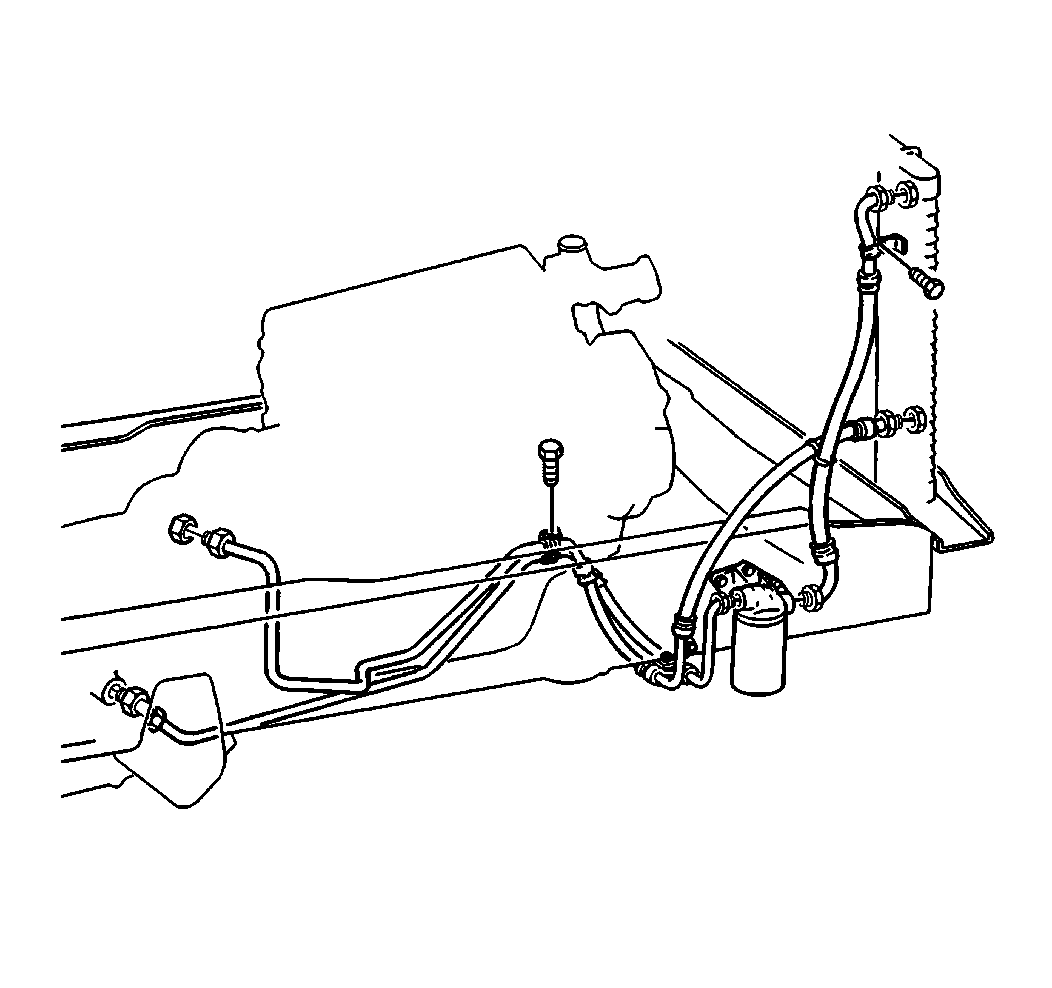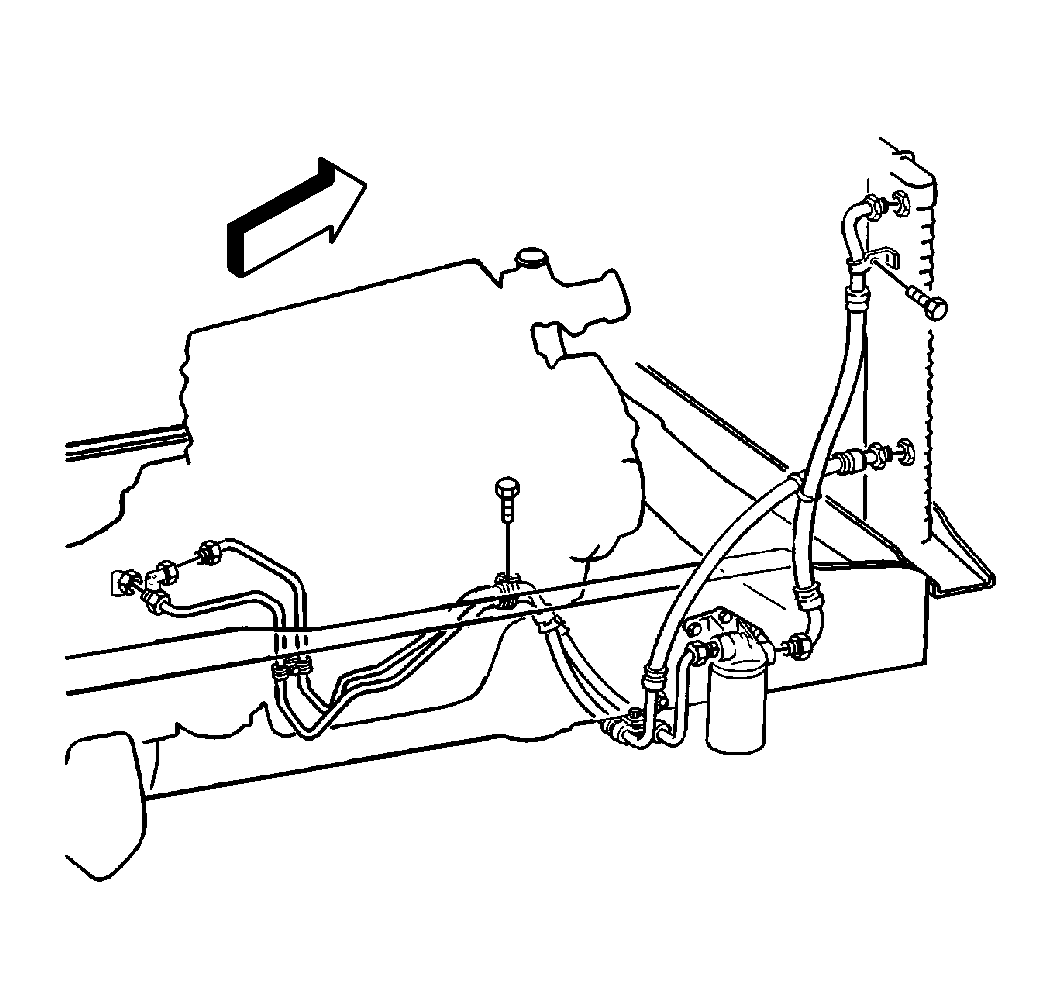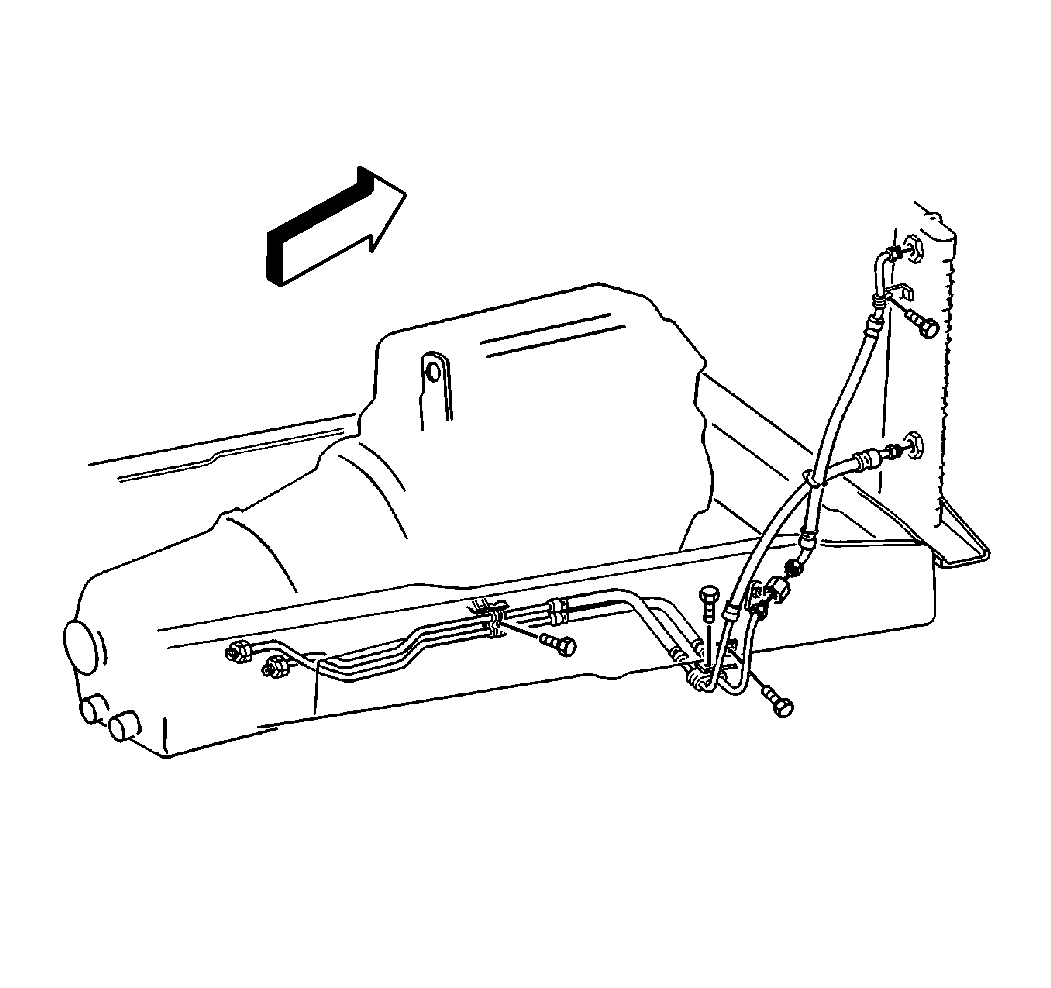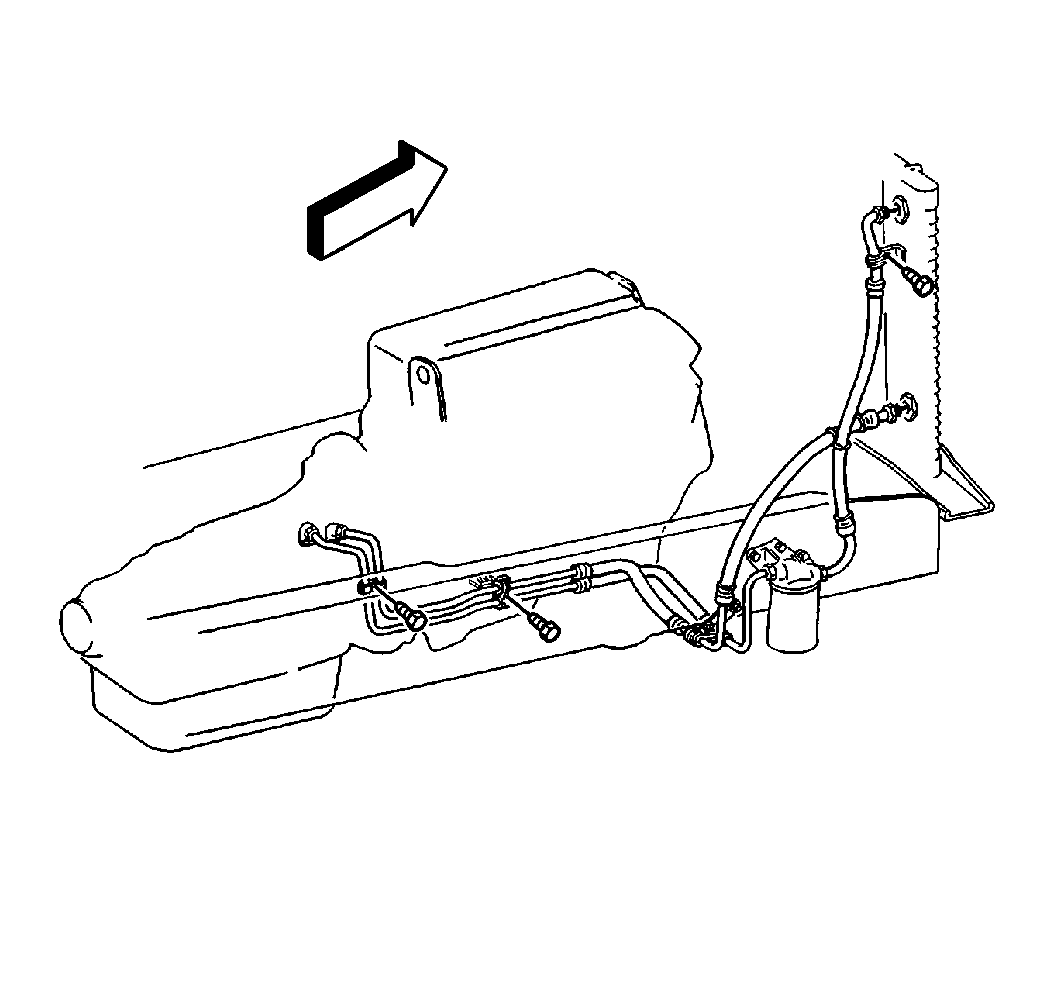Transmission Oil Cooler Line Replacement 7.4L with MT643/MT653
Removal Procedure

- Remove the bolts, the
washers, the nuts, and the clips that secure the oil cooler lines to the
following parts:
| • | The frame rail brackets |
- Remove the nuts securing the oil cooler lines to the radiator
and the transmission.
| • | Plug the ends of the oil cooler lines with a lint-free material. |
| • | Plug the openings to the radiator with a lint-free material. |
- Remove the nuts securing the oil cooler lines to the oil filter
adapter.
| • | Plug the ends of the oil cooler lines with a lint-free material. |
| • | Plug the openings to the oil filter adapter with a lint-free material. |
- Remove the oil cooler lines from the vehicle.
Installation Procedure

- Install the oil cooler
lines to the vehicle.
Notice: Use the correct fastener in the correct location. Replacement fasteners
must be the correct part number for that application. Fasteners requiring
replacement or fasteners requiring the use of thread locking compound or sealant
are identified in the service procedure. Do not use paints, lubricants, or
corrosion inhibitors on fasteners or fastener joint surfaces unless specified.
These coatings affect fastener torque and joint clamping force and may damage
the fastener. Use the correct tightening sequence and specifications when
installing fasteners in order to avoid damage to parts and systems.
- Install the nuts
in order to secure the oil cooler lines to the oil filter adapter.
Tighten
Tighten the nuts securing the oil cooler lines to the oil filter adapter
to 30 N·m (22 lb ft).
- Install the nuts in order to secure the oil cooler lines to the
radiator and the transmission.
Tighten
Tighten the nuts securing the oil cooler lines to the transmission and
the radiator to 25 N·m (18 lb ft).
- Remove the plugs from the following parts:
| • | The ends of the oil cooler lines |
- Install the bolts, the washers, the nuts, and the clips in order
to secure the oil cooler lines to the following parts:
| • | The frame rail brackets |
- With the engine running, check the oil cooler lines and the connections
for leaks.
Transmission Oil Cooler Line Replacement 7.4L with AT545
Removal Procedure

- Remove the bolts, the washers, the nuts, and the clips that secure the
oil cooler lines to the following parts:
| • | The frame rail brackets |
- Remove the nuts securing the oil cooler lines to the radiator
and the transmission.
| • | Plug the ends of the oil cooler lines with a lint-free material. |
| • | Plug the openings to the radiator with a lint-free material. |
- Remove the nuts securing the oil cooler lines to the oil filter
adapter.
| • | Plug the ends of the oil cooler lines with a lint-free material. |
| • | Plug the openings to the oil filter adapter with a lint-free material. |
- Remove the oil cooler lines from the vehicle.
Installation Procedure

- Install the oil cooler lines to the vehicle.
Notice: Use the correct fastener in the correct location. Replacement fasteners
must be the correct part number for that application. Fasteners requiring
replacement or fasteners requiring the use of thread locking compound or sealant
are identified in the service procedure. Do not use paints, lubricants, or
corrosion inhibitors on fasteners or fastener joint surfaces unless specified.
These coatings affect fastener torque and joint clamping force and may damage
the fastener. Use the correct tightening sequence and specifications when
installing fasteners in order to avoid damage to parts and systems.
- Install the nuts
in order to secure the oil cooler lines to the oil filter adapter.
Tighten
Tighten the nuts securing the oil cooler lines to the oil filter adapter
to 30 N·m (22 lb ft).
- Install the nuts in order to secure the oil cooler lines to the
radiator and the transmission.
Tighten
Tighten the nuts securing the oil cooler lines to the transmission and
the radiator to 25 N·m (18 lb ft).
- Remove the plugs from the following parts:
| • | The ends of the oil cooler lines |
- Install the bolts, the washers, the nuts, and the clips in order
to secure the oil cooler lines to the following parts:
| • | The frame rail brackets |
- With the engine running, check the oil cooler lines and the connections
for leaks.
Transmission Oil Cooler Line Replacement 7.2L MT643/653 Filter On Right
Removal Procedure

- Remove the bolts, the
washers, the nuts, and the clips that secure the oil cooler lines to the
following parts:
| • | The frame rail brackets |
- Remove the nuts securing the oil cooler lines to the radiator
and the transmission.
| • | Plug the ends of the oil cooler lines with a lint-free material. |
| • | Plug the openings to the radiator with a lint-free material. |
- Remove the nuts securing the oil cooler lines to the oil filter
adapter.
| • | Plug the ends of the oil cooler lines with a lint-free material. |
| • | Plug the openings to the oil filter adapter with a lint-free material. |
- Remove the oil cooler lines from the vehicle.
Installation Procedure

- Install the oil cooler
lines to the vehicle.
Notice: Use the correct fastener in the correct location. Replacement fasteners
must be the correct part number for that application. Fasteners requiring
replacement or fasteners requiring the use of thread locking compound or sealant
are identified in the service procedure. Do not use paints, lubricants, or
corrosion inhibitors on fasteners or fastener joint surfaces unless specified.
These coatings affect fastener torque and joint clamping force and may damage
the fastener. Use the correct tightening sequence and specifications when
installing fasteners in order to avoid damage to parts and systems.
- Install the nuts
in order to secure the oil cooler lines to the oil filter adapter.
Tighten
Tighten the nuts securing the oil cooler lines to the oil filter adapter
to 30 N·m (22 lb ft).
- Install the nuts in order to secure the oil cooler lines to the
radiator and the transmission.
Tighten
Tighten the nuts securing the oil cooler lines to the transmission and
the radiator to 25 N·m (18 lb ft).
- Remove the plugs from the following parts:
| • | The ends of the oil cooler lines |
- Install the bolts, the washers, the nuts, and the clips in order
to secure the oil cooler lines to the following parts:
| • | The frame rail brackets |
- With the engine running, check the oil cooler lines and the connections
for leaks.
Transmission Oil Cooler Line Replacement 7.2L with MD Series
Removal Procedure

- Remove the bolts, the washers, the nuts, and the clips that secure the
oil cooler lines to the following parts:
| • | The frame rail brackets |
- Remove the nuts securing the oil cooler lines to the radiator
and the transmission.
| • | Plug the ends of the oil cooler lines with a lint-free material. |
| • | Plug the openings to the radiator with a lint-free material. |
- Remove the nuts securing the oil cooler lines to the oil filter
adapter.
| • | Plug the ends of the oil cooler lines with a lint-free material. |
| • | Plug the openings to the oil filter adapter with a lint-free material. |
- Remove the oil cooler lines from the vehicle.
Installation Procedure

- Install the oil cooler lines to the vehicle.
Notice: Use the correct fastener in the correct location. Replacement fasteners
must be the correct part number for that application. Fasteners requiring
replacement or fasteners requiring the use of thread locking compound or sealant
are identified in the service procedure. Do not use paints, lubricants, or
corrosion inhibitors on fasteners or fastener joint surfaces unless specified.
These coatings affect fastener torque and joint clamping force and may damage
the fastener. Use the correct tightening sequence and specifications when
installing fasteners in order to avoid damage to parts and systems.
- Install the nuts
in order to secure the oil cooler lines to the oil filter adapter.
Tighten
Tighten the nuts securing the oil cooler lines to the oil filter adapter
to 30 N·m (22 lb ft).
- Install the nuts in order to secure the oil cooler lines to the
radiator and the transmission.
Tighten
Tighten the nuts securing the oil cooler lines to the transmission and
the radiator to 25 N·m (18 lb ft).
- Remove the plugs from the following parts:
| • | The ends of the oil cooler lines |
- Install the bolts, the washers, the nuts, and the clips in order
to secure the oil cooler lines to the following parts:
| • | The frame rail brackets |
- With the engine running, check the oil cooler lines and the connections
for leaks.
Transmission Oil Cooler Line Replacement 7.2L with AT545
Removal Procedure

- Remove the bolts, the washers, the nuts, and the clips that secure the
oil cooler lines to:
| • | The frame rail brackets |
- Remove the nuts securing the oil cooler lines to the radiator
and the transmission.
| • | Plug the ends of the oil cooler lines with a lint-free material. |
| • | Plug the openings to the radiator with a lint-free material. |
- Remove the nuts securing the oil cooler lines to the oil filter
adapter.
| • | Plug the ends of the oil cooler lines with a lint-free material. |
| • | Plug the openings to the oil filter adapter with a lint-free material. |
- Remove the oil cooler lines from the vehicle.
Installation Procedure

- Install the oil cooler lines to the vehicle.
Notice: Use the correct fastener in the correct location. Replacement fasteners
must be the correct part number for that application. Fasteners requiring
replacement or fasteners requiring the use of thread locking compound or sealant
are identified in the service procedure. Do not use paints, lubricants, or
corrosion inhibitors on fasteners or fastener joint surfaces unless specified.
These coatings affect fastener torque and joint clamping force and may damage
the fastener. Use the correct tightening sequence and specifications when
installing fasteners in order to avoid damage to parts and systems.
- Install the nuts
in order to secure the oil cooler lines to the oil filter adapter.
Tighten
Tighten the nuts securing the oil cooler lines to the oil filter adapter
to 30 N·m (22 lb ft).
- Install the nuts in order to secure the oil cooler lines to the
radiator and the transmission.
Tighten
Tighten the nuts securing the oil cooler lines to the transmission and
the radiator to 25 N·m (18 lb ft).
- Remove the plugs from the following parts:
| • | The ends of the oil cooler lines |
- Install the bolts, the washers, the nuts, and the clips in order
to secure the oil cooler lines to the following parts:
| • | The frame rail brackets |
- With the engine running, check the oil cooler lines and the connections
for leaks.
Transmission Oil Cooler Line Replacement 7.2L MT Filter On Left
Removal Procedure

- Remove the bolts, the
washers, the nuts, and the clips that secure the oil cooler lines to the
following parts:
| • | The frame rail brackets |
- Remove the nuts securing the oil cooler lines to the radiator
and the transmission.
| • | Plug the ends of the oil cooler lines with a lint-free material. |
| • | Plug the openings to the radiator with a lint-free material. |
- Remove the nuts securing the oil cooler lines to the oil filter
adapter.
| • | Plug the ends of the oil cooler lines with a lint-free material. |
| • | Plug the openings to the oil filter adapter with a lint-free material. |
- Remove the oil cooler lines from the vehicle.
Installation Procedure

- Install the oil cooler
lines to the vehicle.
Notice: Use the correct fastener in the correct location. Replacement fasteners
must be the correct part number for that application. Fasteners requiring
replacement or fasteners requiring the use of thread locking compound or sealant
are identified in the service procedure. Do not use paints, lubricants, or
corrosion inhibitors on fasteners or fastener joint surfaces unless specified.
These coatings affect fastener torque and joint clamping force and may damage
the fastener. Use the correct tightening sequence and specifications when
installing fasteners in order to avoid damage to parts and systems.
- Install the nuts
in order to secure the oil cooler lines to the oil filter adapter.
Tighten
Tighten the nuts securing the oil cooler lines to the oil filter adapter
to 30 N·m (22 lb ft).
- Install the nuts in order to secure the oil cooler lines to the
radiator and the transmission.
Tighten
Tighten the nuts securing the oil cooler lines to the transmission and
the radiator to 25 N·m (18 lb ft).
- Remove the plugs from the following parts:
| • | The ends of the oil cooler lines |
- Install the bolts, the washers, the nuts, and the clips in order
to secure the oil cooler lines to the following parts:
| • | The frame rail brackets |
- With the engine running, check the oil cooler lines and the connections
for leaks.












